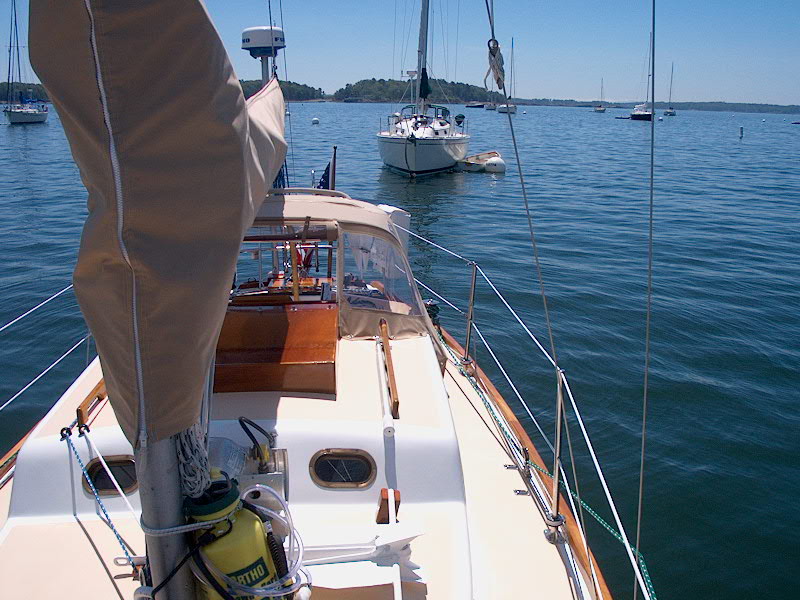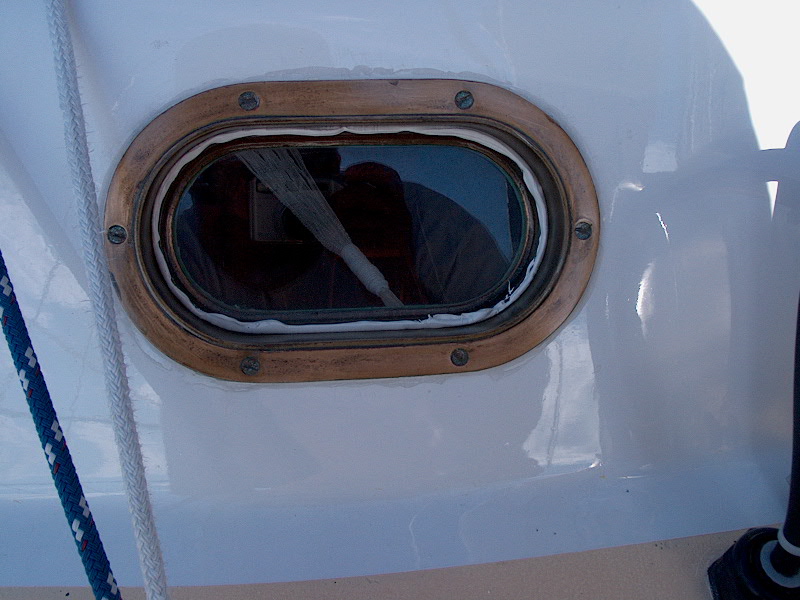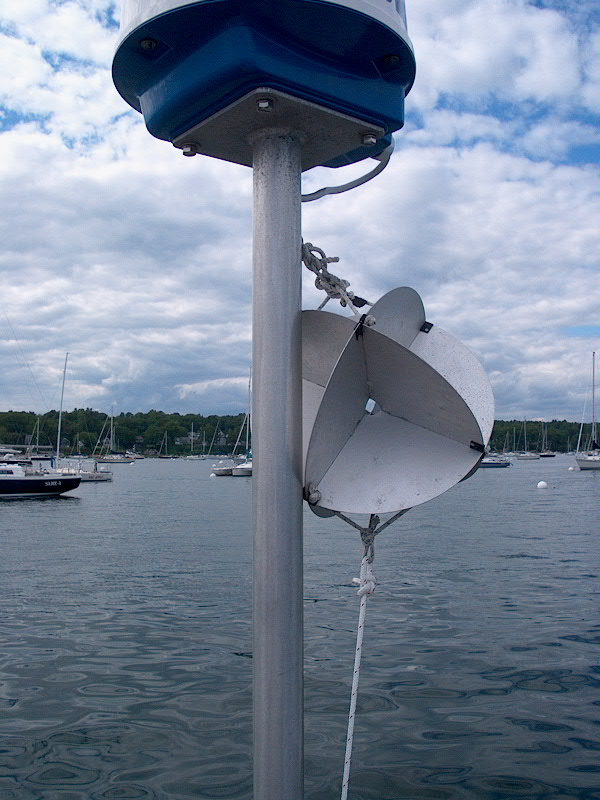|
|
|||||||||||||
| HOME | :: | WHAT'S NEW | :: | PROJECTS | :: | SAILING | :: | MAINTENANCE | :: | RESOURCES | |||
| SAILING LOGS :: EQUIPMENT AND STORAGE :: MISCELLANY | |||||||||||||
|
Nope--no sailing today. Today was a big project day...with the beginning of our cruise looming ever closer, it was time to get down to brass tacks and take care of some of the things on my list--stuff that had been on the list for seemingly forever. I was able to wrap up my office work by late morning, and headed for the boat with a firm project list in hand.
First on my work list for the day was a long-overdue oil change. I started the engine and puttered with a few things while I waited for it to heat up and warm the oil. I had brought with me new oil (plus extra to keep on board), a new hand pump, a container to pump into, and some rags and other things I thought I would need. After running the engine for about 30 minutes, I was just getting ready to commence the oil change when I realized that I had forgotten to buy a strap wrench for the oil filter. OW, I hate when I forget a critical tool! However, I headed right in and drove a few miles to the nearest hardware store, only to be told unapologetically that "we don't stock one" when I asked about the wrench. Grrrrr! I've never liked that store anyway, and now I remembered why. So, I returned to my truck and drove with much frustration several miles back in the other direction, roughly towards my favorite hardware store and home. I wasn't sure as I drove whether I'd just drive the extra 7-mile round trip all the way to my home, or stop at the hardware store for a new wrench (I had both strap wrenches and oil filter wrenches at home). I ended up stopping at the store and bought a new strap wrench, a type I've used with good luck before. Then, I drove back to the boat. Nothing is ever easy. Back on the boat, I began by removing the dipstick and inserting the tube from my pump. At struck oil almost immediately when I began to pump, and was pleased that it was going to be (apparently) easy. Before beginning, I had changed into an older T-shirt just in case I got a little spot of oil on me. Before long, though, I couldn't seem to get any more oil to pump. I had certainly not pumped enough out yet. Puzzled, I pulled out the tube and reinserted it, then tried pumping again. Before I knew it, a big burst of air came through the pump, and splattered into the oil in my bucket--spraying hot, dirty, contaminated oil all over me and, to a lesser extent, the cabinets inside the boat. (Fortunately, I had removed the cushion...) My shirt was covered. Of course, I accepted this new turn of events with the best humor and simply laughed off the annoyance. Then, to make up for it, I sprouted wings and enjoyed a quick flight over the beautiful islands of Casco Bay. Back on the boat (and once again firmly ensconced in reality), I cleaned up the mess and then, with a rag covering the bucket, continued my pumping attempts. Eventually I removed what looked to be something between 1 and 2 quarts of oil (the reservoir holds 2 liters), so I figured I must be done. I installed the dipstick and saw that it was reading dry. So, I moved on to the oil filter. The oil filter on a Yanmar 2GM20F is on the port right side, near the front. Access isn't too bad, but it could be better. To make matters worse, though, the alternator is directly above. I don't remember how it was with the stock alternator, but with the aftermarket alternator, there is very little clearance between the filter and the alternator housing. "No problem", thought I, "I'll just wrap the wrench around the very end of the filter." While there is nothing inherently wrong with this plan, I found that my new strap wrench just slipped and slid over the shiny, gray=-painted exterior of the original oil filter. A fun time was had by all as, time and again, my attempts to make the thing grip failed. My next plan was to move the strap closer to the base of the filter. However, the clearance between the alternator and the filter was just too tight for my silly strap to pass through, no matter how hard I tried...and tried...and tried. With frustration reaching its apex, I gave up on the filter for now and instead filled the oil. It took about 1.75 quarts, which was about right. After checking the fill level, I started the engine and ran it for a while--all OK. I'll have to change that filter the next time I go out (now armed with a proper filter wrench). Elapsed time: 3 hours.
My solution was to open each port, and lay a bead of polysulfide on the existing rubber seal, then close them again, tightening down the dogs--effectively sealing the ports closed. (Sacrilege, I know!) It sure beats having a drip every time it rains, and we never open these anyway. Someday, perhaps I'll more fully restore these ports, or even replace them with new castings, hence returning them to operating condition. But for now, I think I will be happy to have them sealed. Later, I'll remove that excess bead of caulk.
Next, I turned to another long-procrastinated project: installing some reefing tie-up lines (there must be a real name for these) in the two reef points on the mainsail. These allow the loose sail to be tied up to the boom when reefed; they don't really hold the sail in place, although they can help reduce a belly in the middle of the sail that can occur when reefed. To make these, I simply cut six (three for each reef point) lengths of 1/4" braided line to a length I determined would be appropriate, burned the ends, and then ran each line through the grommets in the sail, securing them in the center with an overhand knot on each side. This allows them o just dangle there when not in use. Click here for a little more information and a photo. I also spent a good bit of time inventorying some of the stuff on board to help determine what else we needed to bring or buy. Heidi and I had a big Wal-Mart trip planned for later in the evening, so I wanted to knock off as much of our "buy" list as possible. The cruise suddenly seems very close, and these lists really have to be crossed out. I'm wrapping up my "real" work in a little over a week, at the beginning of July, and Heidi's work is done as of July 12. I'll need those two weeks to finish loading the boat, running the errands, and taking care of final shoreside projects and responsibilities (more about that here). Finally, though, after a couple smaller projects, I wrapped up the list and relaxed in the cockpit with my last cold beer. The day had turned sunny again, after several hours of clouds during the mid afternoon, and it was nearly glassy calm and very nice out. Nathan Sanborn on Dasein swung by on his way in from his own sail--which was cut short by a lack of wind--and tied up alongside for a while we chatted. Heidi came out after work and relaxed for a while, and then the two of us measured for a couple impending canvas projects that need to get done before we leave: a cockpit awning and cowl vent cover. (More on those later.) Sadly, at about 7:30 we decided we really needed to get ashore for that exciting Wal-Mart run (during which we overflowed a shopping cart). |
|||||||||||||
|
|||||||||||||

 For
a change, the weather was actually nice! Last weekend was simply
horrible--50° temperatures, heavy rain, and high winds. I was away on
Saturday, the day with the highest winds, but all reports from people who were
around indicate 5' waves in the anchorage (yikes!), heavy rain, and pure
misery. But today, Tuesday, was sunny and pleasant, and some early morning
fog had burned off by the time I arrived, although I could still see fog fingers
oozing in and around the outer islands. The winds were calm and only
forecast to be around 10 knots, and it was warm. Ahhh...
For
a change, the weather was actually nice! Last weekend was simply
horrible--50° temperatures, heavy rain, and high winds. I was away on
Saturday, the day with the highest winds, but all reports from people who were
around indicate 5' waves in the anchorage (yikes!), heavy rain, and pure
misery. But today, Tuesday, was sunny and pleasant, and some early morning
fog had burned off by the time I arrived, although I could still see fog fingers
oozing in and around the outer islands. The winds were calm and only
forecast to be around 10 knots, and it was warm. Ahhh... Next
on the list was dealing with the forward-facing ports in the salon.
Ever since launch last year, these have leaked because the low side of each port
did not have a dog (all my ports have only one dog), and I couldn't screw the
other one down tight enough for a good seal. Since these ports collect
water when it rains, I would get a slow drip inside afterwards. I had
gotten used to keeping small bowls underneath the drip lines to catch the water,
but this was getting old and with our long cruise coming up I figured something
would have to be done.
Next
on the list was dealing with the forward-facing ports in the salon.
Ever since launch last year, these have leaked because the low side of each port
did not have a dog (all my ports have only one dog), and I couldn't screw the
other one down tight enough for a good seal. Since these ports collect
water when it rains, I would get a slow drip inside afterwards. I had
gotten used to keeping small bowls underneath the drip lines to catch the water,
but this was getting old and with our long cruise coming up I figured something
would have to be done. I
have a slick Mobri radar reflector on the mast, mounted above the headstay on
the front of the mast. (See how
I
have a slick Mobri radar reflector on the mast, mounted above the headstay on
the front of the mast. (See how